Nine new gamma-ray pulsars
Discoveries in Fermi telescope data thanks to method used in gravitational-wave astronomy
Pulsars are the lighthouses of the universe. These compact and fast-rotating neutron stars flash many times per second in the radio or gamma-ray band. Pure gamma-ray pulsars are extremely difficult to find despite their high energy because they radiate very few photons per unit of time. Using an improved analysis algorithm, scientists from the Max Planck Society and international partners now discovered a set of previously unknown gamma-ray pulsars with low luminosity in data from the Fermi satellite. These pulsars had been missed using conventional methods. The number of known gamma-ray pulsars has thus grown to over 100. (The paper will be published in the Astrophysical Journal.)
These cosmic beacons still pose a few puzzles for scientists: not all radio pulsars can be identified as gamma-ray pulsars and on the other hand, not all gamma-ray pulsars are "visible" in the radio band. A plausible explanation is the varying width of the light cone over the wavelength range. This may be because emissions at different wavelengths spread out differently. Lower- energy radio waves are bundled more tightly at the magnetic pole of a neutron star field while the cone of high-energy gamma-rays will spread out. Depending on their spatial orientation and intensity of the cone a pulsar will thus be observed as a radio and/or gamma-ray pulsar. However, other models also describe this phenomenon. To determine the actual cause, as many sources should be examined as possible.
The search for pure gamma-ray pulsars literally starts with the scientists “in the dark”. A typical pulsar will rotate several times per second, or at least 108 times per year. Its emission region will sweep across the observer with that frequency. The Large Area Telescope (LAT) on NASA’s Fermi Satellite however only detects an average of a few thousand photons per year from any given gamma pulsar. This low detection rate makes it extremely hard even for the fastest supercomputers to assign the individual gamma quanta to an unknown pulsar with a defined rotation period.
For several months, scientists from the Max Planck Institute for Gravitational Physics (Albert Einstein Institute/AEI) in Hannover, the Leibniz University of Hannover and the Max Planck Institute for Radio Astronomy in Bonn analyzed data from the LAT in an international collaboration. Using a new method they have been able to identify nine new pulsars which were "invisible” up to now.
“We used a new kind of hierarchical algorithm which we had originally developed for the search for gravitational waves”, explains Bruce Allen, director at the AEI and professor at the Institute for Gravitational Physics of the Leibniz Universität Hannover. “It’s like digging for diamonds or gold: it’s very exciting when you find something”, Allen continues.
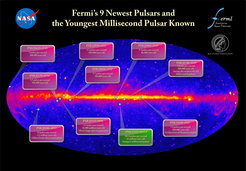
The nine new pulsars netted by the scientists emit less gamma radiation than those previously known and rotate between three and twelve times per second. Only one of these pulsars was later also found to emit radio waves. The total number of gamma pulsars observed by Fermi has thus risen to over 100.
About three-quarters of the gamma pulsars previously observed by Fermi had first been been identified as radio pulsars. In these cases the search for additional gamma radiation is relatively easy. Sky position, rotation period and rotation period change rate are all derived from the radio data, so it takes only a few additional calculations to determine whether detected gamma quanta match a particular set of parameters or not.
A blind search is far more complex as neither position nor pulse period and its change over time are known. At first, each photon from a particular observation sector is assigned a certain probability for a sky position. If a significant accumulation of gamma quanta is observed from a rough direction in the sky, scientists check if the photon’s arrival time at Fermi’s on-board detector matches an exact sky position and pulse period and its change over time. However, with only a few thousand photons detected over a period of three years but rotation frequencies of only a few Hertz, a huge number of prospects has to be tested.
During a first blind search in Fermi data, astronomers found 24 pure gamma pulsars within one year of the launch of the satellite in 2008. A further two were discovered in the following year. After that, the number of new pulsars stagnated until physicists from Hannover started searching with an algorithm that is 10 times more efficient, and employing additional computing power. They found a further nine gamma-ray pulsars which on average emit only one quarter of the photons compared to previously discovered pure gamma-ray pulsars.
Scientists at the MPI Bonn examined the emission spectra of the corresponding gamma-ray sources to see whether they were candidates for the gamma-ray pulsar blind search. "About one- third of the gamma-ray sources observed by LAT were unknown before the launch of Fermi," says Lucas Guillemot, a member of the research group of Michael Kramer, director at the MPIfR. "We determined the spectral properties of the Fermi LAT sources, and compared them to those of known gamma-ray," he said.
The candidates for a gamma-ray pulsar blind search were then analyzed in detail. “The new computing method permits us to evaluate data sets much faster than before”, said Holger Pletsch, a member of Allen’s group leading the effort. The analysis was also run on the ATLAS computing cluster at the AEI in Hannover. ATLAS has one hundred times the computing power that was used in previous blind searches. “Together with the more efficient analysis, this does not only mean that we can analyze the data much faster. We can now search for gamma-ray pulsars which rotate even faster, with periods measured in milliseconds”, adds Pletsch. The computing power needed for the search increases proportionally to the cube of the rotation period.
Additionally, part of the computing power of the Einstein@Home project is now allocated to the search for the first pure gamma-ray millisecond-pulsar. This discovery would be a significant contribution to our understanding of pulsars.
Visuals after page break.
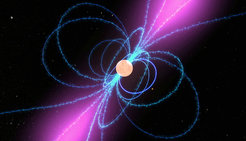
Pulsars are the lighthouses of the universe. These compact and fast-rotating neutron stars flash many times per second in the radio or gamma-ray band. Pure gamma-ray pulsars are extremely difficult to find despite their high energy because they radiate very few photons per unit of time. Using an improved analysis algorithm, scientists from the Max Planck Society and international partners now discovered a set of previously unknown gamma-ray pulsars with low luminosity in data from the Fermi satellite. These pulsars had been missed using conventional methods. The number of known gamma-ray pulsars has thus grown to over 100. (The paper will be published in the Astrophysical Journal.)
Images and multimedia in support of the news conference
Presenter 3: Bruce Allen, director, Max Planck Institute for Gravitational Physics in Hannover, Germany, and of the Einstein@Home project
Visual 9

Visual 10
Visual 11

Visual 12
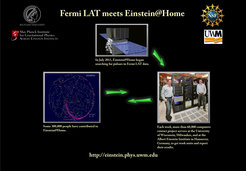
Einstein@Home
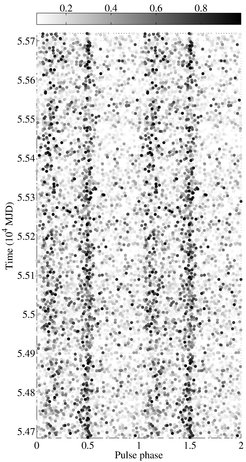
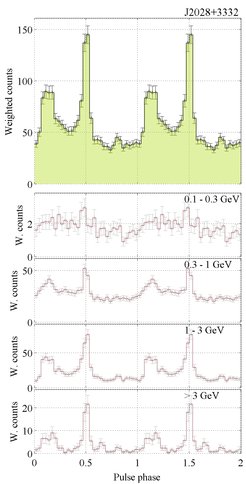
Phase-time diagram and pulse profile for gamma-ray pulsar J2028+3332. Panel 9a shows the pulse phase (rotation angle of the star about its axis) at the arrival time of each photon. The gray-scale intensity represents the photon probability weight. In panel 9b, the upper plot shows the summed probability weights: the pulse profile. The four plots below resolve the pulse profile according to separate energy ranges. For clarity, the horizontal axis shows two pulsar rotations in each diagram.




















